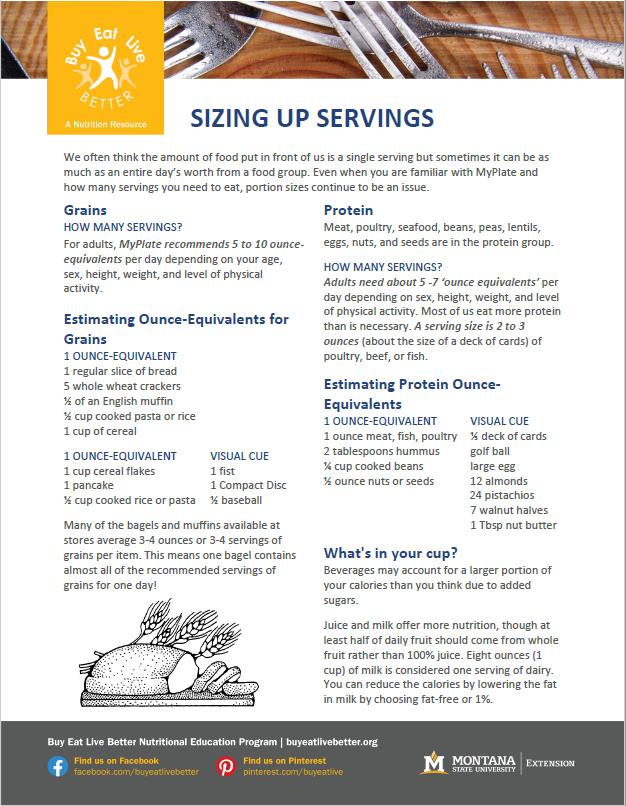Serving Sizes
We often think the amount of food put in front of us is a single serving but sometimes it can be as much as an entire day's worth from a food group. Even when you are familiar with MyPlate and how many servings you need to eat, portion sizes continue to be an issue.
Grains
How many servings?
For adults, MyPlate recommends 5 to 10 ounce equivalents per day depending on your age, sex, height, weight, and level of physical activity.
Estimating Ounce-Equivalents for Grains
1 ounce equivalent
1 regular slice of bread
5 whole wheat crackers
1/2 of an English muffin
1/2 cup cooked pasta or rice
1 cup of cereal
|
1 Ounce-Equivalent
|
Visual Cue
|
|---|---|
|
1 cup cereal flakes
|
1 fist
|
|
1 pancake
|
1 Compact Disc
|
|
1/2 cup cooked rice or pasta
|
1/2 baseball
|
Many of the bagels and muffins available at stores average 3-4 ounces or 3-4 servings of grains per item. This means one bagel contains almost all of the recommended servings of grains for one day!
Protein
Meat, poultry, seafood, beans, peas, lentils, eggs, nuts, and seeds are in the protein group.
How many servings?
Adults need about 5-7 'ounce equivalents' per day depending on sex, height, weight, and level of physical activity. Most of us eat more protein than is necessary. A serving size is 2 to 3 ounces (about the size of a deck of cards) of poultry, beef, or fish.
Estimating Protein Ounce-Equivalents
|
1 Ounce Equivalent
|
Visual Cue
|
|---|---|
|
1 ounce meat, fish, poultry
|
1/3 deck of cards
|
|
2 tablespoons hummus
|
Golf ball
|
|
1/4 cup cooked beans
|
Large egg
|
|
1/2 ounce nuts or seeds
|
|
What's in your cup?
Beverages may account for a larger portion of calories than you think due to added sugars. Juice and milk offer more nutrition, though at least half of daily fruit should come from whole fruit rather than 100% juice. Eight ounces (1 cup) of milk is considered one serving of dairy. You can reduce the calories by lowering the fat in milk by choosing fat-free or 1%.
How much should adults eat daily from each food group?
It depends on your age, sex, height, weight, and level of activity. General recommended amounts for adults are as follows:
What counts as 1 cup of fruit?
- 1/2 cup dried fruit
- 1/2 of a large apple
- 1 large banana
- 2 large plums
- 32 grapes
What counts as 1 cup of vegetables?
- 2 cups of raw, leafy greens
- 2 medium carrots
- 1 large ear of corn
- 2 stalks of celery
- 1 large bell pepper
What counts as an ounce equivalent for meat?
- 1 ounce of meat
- 1 egg
- 1 Tablespoon of peanut butter
- 1/4 cup of cooked beans or lentils
- 1/4 cup of tofu
- 2 Tablespoons hummus
What counts as an ounce-equivalent for grains?
- 1 slice of bread
- 1 cup of ready-to-eat cereal
- 1/2 cup of cooked cereal
- 1/2 cup of cooked rice
- 1/2 cup of cooked pasta
Remember to make half your grains whole grains!
What counts as a cup of dairy?
- 1 cup milk
- 1/3 cup shredded cheese
- 1 1/4 cups cottage cheese
- 1 (8 ounce) container of yogurt
- 1 1/2 ounces hard cheese (size of 3 dominoes)
- 1 cup calcium-fortified soymilk
Oils
Oils are not shown in MyPlate to the right, but they are a part of a healthy dietary pattern. Common oils include canola, olive, corn, peanut, and safflower. The fats in tropical plants like coconut oil and palm oil are not included in the oil category as they contain more saturated fat. Shift fat intake from fats high in saturated fat such as butter, shortening, lard, and coconut oil to fats that are liquid at room temperature. See our fact sheet Oils and Fats for more information on choosing the best oils.


 You may require
You may require